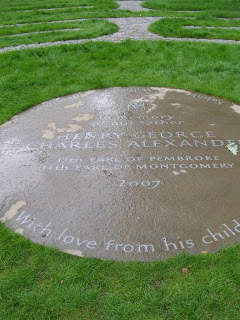 House-hunting at the weekend: there has been progress. But I'm not going to tell you about it as I'm highly superstitious and since it's all built on very shifting sands anyway there's no guarantee that the tottering edifice (the buying-and-selling malarkey, not the house) will stay upright for the required length of time. Here's a moral: never buy, or sell, a house in a credit crunch.
House-hunting at the weekend: there has been progress. But I'm not going to tell you about it as I'm highly superstitious and since it's all built on very shifting sands anyway there's no guarantee that the tottering edifice (the buying-and-selling malarkey, not the house) will stay upright for the required length of time. Here's a moral: never buy, or sell, a house in a credit crunch.The house-hunting involved staying at my mum's in Wiltshire (that's a clue, by the way). And that meant a visit to my very favourite stately home, Wilton House. I discovered that since my last visit the children of the previous Earl of Pembroke, including the 18th Earl of Pembroke and current resident at Wilton, who is also for reasons which are unclear the 15th Earl of Montgomery, have created a miz-maze in honour of their father, who died in 2003.
We went on a little hunt for the maze, which is buried deep in woodland behind the garden, and eventually discovered it nestled in a clearing. The girls spent most of the time scampering around the granite set paths, but we just absorbed the atmosphere: there is something about a miz-maze which is entirely other-worldly and quite apart from the usual amusement-park variety with hedges and lost children and what not.
 Nobody actually knows what miz-mazes were for: they've been around since Roman times, and the Tudors were quite keen on them too. They're labyrinths: that means the paths don't have 'stems' but just curl around each other until you get to the centre. This reduces the chance of getting lost but increases the general sense of mystic meaning that pervades such designs.
Nobody actually knows what miz-mazes were for: they've been around since Roman times, and the Tudors were quite keen on them too. They're labyrinths: that means the paths don't have 'stems' but just curl around each other until you get to the centre. This reduces the chance of getting lost but increases the general sense of mystic meaning that pervades such designs.There are links with witches, who would gather at the sites of miz-mazes; and they're also highly symbolic to Christians who see them as a journey to the central higher truth. Monks are rumoured to have crawled on their hands and knees to the centre of them as a penance. I don't know about all that: but I do know that this one, modern as it was, speaks of primitive meaning and deeper significances than a simple turf path in a wood.
There are a handful of surviving ancient miz-mazes in the country: one near Fordingbridge, in Hampshire, and another on a hill fort somewhere near Winchester. Apparently in the really old ones - made entirely of turf with no hard-landscaped paths - the passage of feet wore the pattern of the labyrinth more deeply and indelibly in to the ground.
But they're enjoying something of a comeback: the miz-maze at Mount Ephraim is probably the best-known example, but is rather un-authentically modern (if gorgeously pretty) in that it uses perennials to divide off the paths and some of the paths have dead ends - which I understand is Not Done in labyrinthine circles.
I rather like the idea of cutting a turf maze into a lawn: probably the easiest way to create a miz-maze. To reproduce the full symbolism you should have nine circles and the path should flow without hindrance back and forth right to the centre. And placing it in a clearing in woodland seems to help, too. As a memorial - as it's been used here - it was deeply meaningful, largely through its simplicity. I've always wanted to be buried under an oak tree when my time is up: I think I may add a miz-maze for good measure, too.







2 comments:
Hi I've been to the mizmaze on the hill above Breamore House which is supposed to be quite old, it's listed so you can't walk on it but it's in a beautiful spot.
The Winchester miz-maze is on St Catherine's Hill which is outside the town and you need a car to get to it. Used to walk the dog there, ruddy steep to get to the top but very interesting and the views were worth it.
Post a Comment